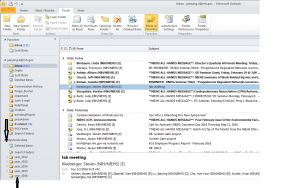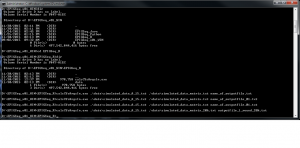Author Archives: Jin Tong
Learning Python Web programming
The most common frame work Django offers great features for web-programming with python.
I have to take care of pip installation on my mac
easy_install is the way to go, yeh.
Here is another help link for django web-development
It is not surprising that nothing will work as simple as it seems. Well, here the first verification failed:
python manage.py runserver
generates
maximum recursion depth exceeded
Someone kindly posted answer. Well, my functools.py is empty.
The answer is “python” had bugs (working with django), so upgrading python installation solved the problem.
Using MySQL in Django
My database is mysql, so I was tying to incorporate MySQL for django. As usual, nothing works as I expected. When I ran python manage migrate, I got error
….
File "/Library/Python/2.7/site-packages/django/db/backends/mysql/base.py", line 28, in
raise ImproperlyConfigured("Error loading MySQLdb module: %s" % e)
django.core.exceptions.ImproperlyConfigured: Error loading MySQLdb module: No module named MySQLdb
….
So, the problem was the “MySQLdb” module as someone pointed out. Well, again the installation itself reached error
RuntimeError: maximum recursion depth exceeded
/Users/li11/django/mysql/MySQL-python-1.2.4b4/distribute-0.6.28-py2.7.egg
Traceback (most recent call last):
File "setup.py", line 7, in
use_setuptools()
File "/Users/li11/django/mysql/MySQL-python-1.2.4b4/distribute_setup.py", line 145, in use_setuptools
return _do_download(version, download_base, to_dir, download_delay)
File "/Users/li11/django/mysql/MySQL-python-1.2.4b4/distribute_setup.py", line 125, in _do_download
_build_egg(egg, tarball, to_dir)
File "/Users/li11/django/mysql/MySQL-python-1.2.4b4/distribute_setup.py", line 116, in _build_egg
raise IOError('Could not build the egg.')
IOError: Could not build the egg.
Using PostgreSQL in Django
It turns out that hooking up django with mysql is not that easy, I have got help from Andy who gave me their project on github repository. Well, they sticked with postgresql version 9.4+.
My mac has 9.0, so I have to upgrade it to 9.4+. It seems that postgres.app provides the easiest solution to mac user.
Next, I need to set path for postgresql
Using the Python virtualenv and virtualenvwrapper
Andy’s project needs these prerequisite, and I found this help doc for virtual environment.
Missing llvm-gcc-4.2 on Mac OS
My configuration failed at
pip install -r requirements/dev.txt
With the following error message
llvm-gcc-4.2 -fno-strict-aliasing -fno-common -dynamic -g -Os -pipe -fno-common -fno-strict-aliasing -fwrapv -mno-fused-madd -DENABLE_DTRACE -DMACOSX -DNDEBUG -Wall -Wstrict-prototypes -Wshorten-64-to-32 -DNDEBUG -g -fwrapv -Os -Wall -Wstrict-prototypes -DENABLE_DTRACE -arch i386 -arch x86_64 -pipe -DPSYCOPG_DEFAULT_PYDATETIME=1 -DPSYCOPG_VERSION="2.5.5 (dt dec pq3 ext)" -DPSYCOPG_EXTENSIONS=1 -DPSYCOPG_NEW_BOOLEAN=1 -DHAVE_PQFREEMEM=1 -DPG_VERSION_HEX=0x09000D -DPSYCOPG_EXTENSIONS=1 -DPSYCOPG_NEW_BOOLEAN=1 -DHAVE_PQFREEMEM=1 -I/System/Library/Frameworks/Python.framework/Versions/2.7/include/python2.7 -I. -I/usr/include -I/usr/include/postgresql/server -c psycopg/psycopgmodule.c -o build/temp.macosx-10.7-intel-2.7/psycopg/psycopgmodule.o
unable to execute llvm-gcc-4.2: No such file or directory
error: command 'llvm-gcc-4.2' failed with exit status 1
Found a bunch of posting. After upgrading ox-10.11, all works out just fine.
People reported same errors This one needs compiling from github source Apple Store is the best answer
I found this website by Marina, I would like to follow this note and get the speed up on python and python web.
My learning notes
Note 1: 2/12/2016
Today,I was looking at the SNP association analysis. I found this write up by Eric Minikel is very helpful.
Matti Pirinen from Finland has a good website also.
Working with miRBase v21
This is an embarrassed note as I could not download miRBase using ftp. Hopefully, I can figure it out somehow and keep a note for future use.
Scenario I: I wanted to download database files from mirbase ftp server
I was at miRBase download page Here is the README file I clicked Go to the FTP site to download al file. From my linux window, " ftp ftp.mirbase.org/pub/mirbase/21/database_files/" gets me "unknown host" error What did I do wrong??
Well, the fix is simple, the serve name was only mirbase.org haha
ftp mirbase.org user: anonymous pass: li11@niehs.nih.gov prompt
Frank created a database called miRBaseV21 on the “wine” server
mysql> show grants for li11;
| GRANT ALL PRIVILEGES ON `li11`.* TO ‘li11’@’%’ WITH GRANT OPTION
| GRANT ALL PRIVILEGES ON `mirDB`.* TO ‘li11’@’%’
| GRANT ALL PRIVILEGES ON `methylSNPdb`.* TO ‘li11’@’%’
| GRANT ALL PRIVILEGES ON `miRBaseV21`.* TO ‘li11’@’%’
| GRANT ALL PRIVILEGES ON `mus_musculus_core_73_38`.* TO ‘li11’@’%’
Scenario II: I need to create the schema downloaded from mirbase.
It turns out that "mysqldump" does not work following my earlier post, it could be that I do NOT have root privillege Followed this link, I used "mysql> source ~/mysql_jyl/miRBase/miRBaseV21/tables.sql" ;
In the end, I imported all the data into the database:
mysql> load data local infile ‘~/mysql_jyl/miRBase/miRBaseV21/wikipedia.txt’ into table wikipedia ;
Now, I am working on R scripts for the analytical components. At first, I have to work on connecting to the mysql database. Here are a few lines of code to connect:
library(RMySQL) mydb = dbConnect(MySQL(), user='li11', password='password', dbname='mirDB', host='wine.niehs.nih.gov') dbListTables(mydb) dbListFields(mydb, 'resCenter')
It turns out that it is quite simple and straightforward with the following help links:
Main link at R-blogger A brief tutorial post by Manoj Kumar
To transfer my RATEmiRs from wine to my windows machine, here are a few simple steps:
1. On linux, do the mysqldump: mysqldump -u li11 -ppassword RATEmiRs > ~/RATEMiRs.sql 2. On windows machine: Log in mysql database and create a database (create database ratemirs) 3. Do a simple restore: mysql -u li11 -p ratemirs < x:\RATEMiRs.sql
Working with my outlook client
With the new computer, I could NOT find the “MyOwnArchive”.
Through very hard effort, I got it done
It turns out, this “MyOwnArchive.pst” has been backed up by the server and all my “local” folders are recovered. Therefore, I decided to document this with a successful screenshot.
Protected: Python note
Install scipy on windows machine
In order to run complex python for numerical process, especially for those statistical modules and modeling, I need to install scipy on my window machines. It sounds trial, but there are plenty of involvement before I can even install this module. Therefore, I would like to take a note how I am going to do it in case others will have same request.
With numpy installed, I had this error “no lapack/blas resources found”. Okay, what does this mean? It turns out
Hopefully, I have found out the solution.
I need the MinGW for windows first
No solution yet!!
Getting genotype for human cell line
Human cell line was obtained from Coriell Institute
db SNP_ind_id was available form NCBI
A good tutorial post at Biostars
Using MatLab executable for EPIG-Seq application
For EPIG-Seq development in R, the biggest hurdle is the running speed in R. Therefore, we are investigating using MatLab compiled the executable in R. Pierre developed the MatLab application and compile it into an windows executable.
Here is a screenshot for using this application in Windows: 
To measure the execution time, I found this useful web-link here.
Here is timecmd.bat
@echo off
@setlocal
set start=%time%
:: runs your command
cmd /c %*
set end=%time%
set options="tokens=1-4 delims=:."
for /f %options% %%a in ("%start%") do set start_h=%%a&set /a start_m=100%%b %% 100&set /a start_s=100%%c %% 100&set /a start_ms=100%%d %% 100
for /f %options% %%a in ("%end%") do set end_h=%%a&set /a end_m=100%%b %% 100&set /a end_s=100%%c %% 100&set /a end_ms=100%%d %% 100
set /a hours=%end_h%-%start_h%
set /a mins=%end_m%-%start_m%
set /a secs=%end_s%-%start_s%
set /a ms=%end_ms%-%start_ms%
if %hours% lss 0 set /a hours = 24%hours%
if %mins% lss 0 set /a hours = %hours% - 1 & set /a mins = 60%mins%
if %secs% lss 0 set /a mins = %mins% - 1 & set /a secs = 60%secs%
if %ms% lss 0 set /a secs = %secs% - 1 & set /a ms = 100%ms%
if 1%ms% lss 100 set ms=0%ms%
:: mission accomplished
set /a totalsecs = %hours%*3600 + %mins%*60 + %secs%
echo command took %hours%:%mins%:%secs%.%ms% (%totalsecs%.%ms%s total)
There are three flavors of EPIG-Seq deployments: windows executable, windows-based java application, and linux-based java application. With either situation, one need to Verify that the Matlab Runtime Compiler (MCR) is installed and ensure you have version 8.3 (R2014a)
If the MCR is not installed, do the following:
Execute the MyAppInstaller_web.install file to extract and install Matlab library files via the web. You will need internet access and may need to be an administrator to do so.
The MCR Installer will launch. Click next, then accept agreement, then indicate the path where you want the runtime environment installed. This will be your
The install may take a couple of hours depending on your network speed.
Or manually download and install the Linux x86-64-bit version of the MCR for R2014a
from the MathWorks Web site by navigating to
http://www.mathworks.com/products/compiler/mcr/index.html
Learning python
Python is a very useful computer programming language with online document here.
Here is where the library was not completely installed. But some features were returned to MicroSoft
A good video on apache webserver installation
I found PyCharm Introductory tutorial is very helpful.
Scenario 1, To install NumPy module
Scenario 2, To install SciPy module
This is my first task in python, SciPy can be found here.
